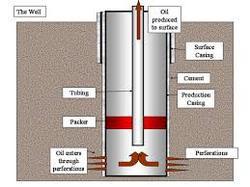In cased hole completions, production casing is run along the entire length of the well and through the reservoir. The cased hole effectively acts as a control mechanism for safe production of desired hydrocarbons and as a barrier preventing the reintroduction of unwanted fluids, gases, and solids into the wellbore. For a more efficient downhole completion, check out Gryphon Oilfield’s selection of completion tools and casing equipment.
How is a cased hole completion performed?
After the drill string has been removed, a continuous coupling of casings of different diameters is run into the well at varying depths and secured to the formation in a process known as Cementing. ‘Cement’ here refers to a mixture of cement and certain additives which is pumped into the well and fills the vacuum between the casing and surrounding formation.
After the wellbore has been completely insulated from the surrounding formation, the casing must be perforated to stimulate production from viable sections of the reservoir called pay zones. Perforation is performed using Perforating guns which set off controlled explosions that blast holes through specific sections of the casing (and into the reservoir) for controlled production of hydrocarbons.
Advantages of cased hole completions
The following are the main advantages of cased hole:
- The casing effectively screens out contaminants by controlling the production of associated sand, water, gas, and other formation fluids
- Enhances well integrity
- Offers better zonal isolation of the reservoir
- Makes it easier for multiple zones to be completed within the same well
- Work over (remedial) processes is easier to carry out in a cased hole
Drawbacks of cased hole completions
The following are the main disadvantages of cased hole:
- More expensive than an open hole completion due to costs of procuring casings, perforation guns, cement, and other completions equipment
- Limited exposure to the reservoir could affect the volume of production


